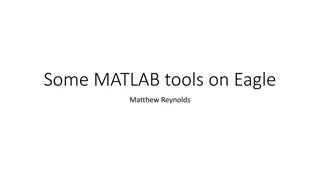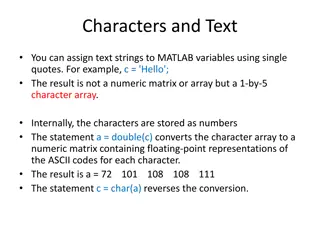Introduction to MATLAB and Simulink for ECEN 2060 Tutorial
MATLAB and Simulink are essential tools for technical computing and simulations in engineering and science fields. This tutorial provides a basic introduction to MATLAB and Simulink for ECEN 2060, covering topics such as programming, model-based simulation, and building simple circuit models. Students can learn to create and simulate models using standard Simulink blocks, execute MATLAB commands, and understand key functionalities to complete homework assignments effectively.
Download Presentation

Please find below an Image/Link to download the presentation.
The content on the website is provided AS IS for your information and personal use only. It may not be sold, licensed, or shared on other websites without obtaining consent from the author.If you encounter any issues during the download, it is possible that the publisher has removed the file from their server.
You are allowed to download the files provided on this website for personal or commercial use, subject to the condition that they are used lawfully. All files are the property of their respective owners.
The content on the website is provided AS IS for your information and personal use only. It may not be sold, licensed, or shared on other websites without obtaining consent from the author.
E N D
Presentation Transcript
MATLAB/Simulink tutorial ECEN 2060
MATLAB/Simulink MathWorks tools for technical computing and simulations, widely used across various engineering and science disciplines MATLAB Programming language and interactive environment well suited for computing, algorithms, data processing and visualization Simulink Environment for graphical, model-based simulation of dynamic systems Available in all computer labs in the Engineering building Personal copy (full version, but for students only) can be purchased at www,mathworks.com for $99. This is not required for ECEN2060 Tutorial objectives: very basic introduction to the tools at the level sufficient to understand ECEN2060 simulation models and do homework assignments ECEN2060 2
Start MATLAB, then start Simulink Click here to start Simulink Choose Current Directory MATLAB commands and scripts can be executed interactively in the Command Window ECEN2060 3
Simulink Library Browser Library Browser gives access to various standard or additional blocks that are used to build more complicated models ECEN2060 models will be constructed using standard Simulink blocks from the Simulink library Click File - New Model (or Ctrl-N) to start a new model window E 4 CEN2060
Constructing and simulating a simple circuit model Circuit equation: iR = (1/R)vac iR + SineWave block from Sources R 10 vR vac Simulink: output Gain Block from Math Operations V = 1 V M Connect block inputs and outputs according to the circuit equation Double-click a block to change parameter values To better document the model, double-click on the block name or on the connection line to change block and signal names as desired Drag an drop Sine Wave block from Sources in the Library Drag an drop Gain block from MathOperations in the Library Drag an drop Scope block from Sinks in the Library ECEN2060 5
Constructing and simulating a simple circuit model Total simulation time (10 seconds in this example) can be changedhere Click here to start simulation Autoscale Double-click on the Scope block to display the output waveform (current iR) Scope parameters Explore various menu options, block properties, etc. For example: Add another axis to the Scope and display both iR andvR Repeat simulations for different values of the sinewave amplitude or frequency, or differentR ECEN2060 6
Notes Simulink blocks have zero, one or more inputs and zero, one or more outputs Inputs and outputs are all considered signals Unlike circuit-oriented simulators (e.g. Spice), Simulink has no knowledge of whether a signal is voltage, current, power, torque, speed, , which makes it a very general tool for simulations of various dynamical systems, but requires a user to decide which signals are inputs and which signals are outputs, and make block connections to correctly model system equations; as a result, Simulink block diagrams may not be as intuitive as circuit diagrams ECEN2060 7
Another example Make sure you have downloaded pv1.mdl and findMPP.m to a working folder (files are available on the course website, MATLAB/Simulink page) Set MATLAB Current Directory to the folder where you downloaded pv1.mdl and findMPP.m Double- click pv1.mdl to open the PV cell Simulink model ECEN2060 8
Simple PV cell Simulink model pv1.mdl Circuit model Model equations 1) , iPV= ISC iD input iPV = I ( e v /V + =v + i v iD D T D o D PV ISC vPV vD output Product block fromMath Operations XY Graphblock fromSinks ECEN2060 PV cell characteristics PV power Repeating sequence blockfrom Sources Vpv Ppv PV Ipv Ppv Product To Workspace Fcn block fromUser- Defined Functions To Workspace block from Sinks sends simulation results to MATLAB workspacefor further processing I-V characteristic 1e-9*(exp(u/26e-3)-1) Vpv Vpv PN-junction characteristic Id Mux block from Signal Routing combines 3 signals into one vectoroutput 1/1000 1000 ISC Ipv Insolation to ISC current gain Insolation Constant block from Sources pv1.mdl Simulink model ECEN2060 9
Run pv1 simulation Output power Ppv(i.e the product of iPVand vPV) as a function of vPV is immediately displayed in a X-Y Plot window Output current i vPV is immediately displayed in another X-Y Plot window as a function of PV Output power Ppv, current iPV, voltage vPV, and simulation time are stored in a structure variable PV, which is made available (using the To Workspace block) for further processing in the MATLAB Command Window ECEN2060 10
Example of MATLAB processing of simulation results Type findMPP and Enter in the MATLAB Command Window. This runs the MATLAB script findMPP.m, which takes the simulation results and finds the maximum power point (power, voltage and current) and again plots power Ppv and Ipv as functions ofVpv. Double-click on the findMPP.m file to open the script and examine the MATLAB code ECEN2060 11
More notes Simulink model and MATLAB Figure windows include a Copy function in the Edit menu. This is useful for reporting results: you can simply copy and paste your models or graphical results into a Word or PowerPoint document You may want to explore other options in the MATLAB Figure window. For example, find out how add a grid, change the line type, thickness or color, change the x-axis or y-axis scales, etc. This tutorial is very limited in scope, just to get you started with the tools we will be using to model and test various electrical or electro-mechanical energy systems in ECEN2060. You may want to browse through Simulink/MATLAB HELP documentation to further explore the tool capabilities ECEN2060 12























